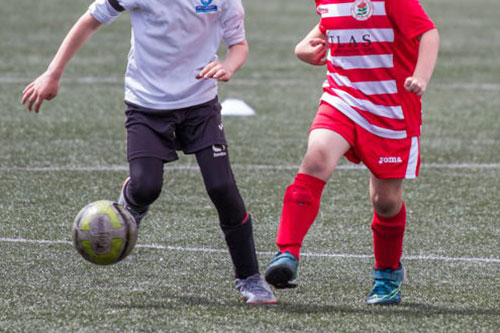Friday April 1st 2022

Every week thousands of kids play on 3G pitches but then bring home half the pitch with them.
Written by Science Editor, Phil Bowen
Bonnyrigg Rose Community Football Club have been working with scientists from Edinburgh Napier University to solve a 3G pitch issue and now look set to reap the dividend.
Every parent or carer with kids who play organised football will recognise the issue. You pick the kids up after training on one of the local 3G pitches and they bring half the pitch home with them. Those annoying black shards of rubber from the pitch either get transferred to the floor of the car, fall out on the doorstep as boots are removed or end up in the washing machine still clinging to socks.
The Bonnyrigg Rose Community Football Club, with over 500 players, decided to do something about the issue whilst they were redeveloping their 3G pitches at Poltonhall. They contacted the nano-technology department at Edinburgh Napier University and the clever professors came up with a solution, the Bonnyrigg Rose Electro-Magnetic pitch, or BREM-pitch for short.
The new 3G pitch has an electro-magnetic plate laid just below the surface of the pitch. When switched on the low level magnetic field exerts a magnetic pull on the rubber shards and prevents them from clinging to boots and socks. Initial tests this week have proven to be very successful in keeping the shards within the BREM-pitch. Players’ boots and socks have been shard free.
The invention has also attracted the attention of the ‘Big Team’ at Bonnyrigg Rose, as the newly crowned Lowland League Champions are interested in using the technology themselves.
Brendan Parkinson, Bonnyrigg’s club secretary explained:
“In the past when we have looked at replacing the pitch at New Dundas Park with 3G, we have always been put off with the high maintenance costs. For the quality of pitch we require then the rubber shards would need replacing every year as the players would take so much of it home on their boots and socks after a game. This would require 1,000 new car tyres to be shredded. Not only is it expensive to buy that many tyres, but we would have to hire the use of the shard shredder.
“The shredder is like a giant industrial cheese grater and it can cost upto £20,000 to hire for the week. Not to mention the extra manpower we would need to operate and distribute the shards evenly across the pitch.”
“The BREM-pitch solves that cost problem.”
“We will also do our bit for the climate as we will power the BREM-pitch with solar panels. We are placing these under the flood lights so that for evening games the lights will power the solar panels which will power the pitch.”
Robbie Horn, Bonnyrigg Rose manager, is also keen on a by-product of the solution. As well as keeping the rubber shards on the pitch, the BREM-pitch also effects footballs and thus keeps them closer to the ground.
In fact tests indicate that the BREM-pitch keeps the ball 18.81% closer to the ground.
Manager Horn said
“We are a good passing team and we like to play the ball on the floor and so if the BREM-pitch helps us keep the ball on the deck then I am all for that.
“As my childhood hero, Brian Clough, used to say ‘If God had wanted us to play football in the sky, He’d have put grass up there.’ ”
“We have checked with the Scottish FA and they say there is nothing in the rules to stop the BREM-pitch being used. In fact they are enthused by it too, as it could aid the national team.”
But the good news does not stop there, as both Bonnyrigg Rose and Edinburgh Napier University will benefit financially when the technology is licensed to other clubs. This is something that the Rose chairman, Charlie Kirkwood, is very happy about.
“The licence fee from the BREM-pitch will secure funding for the club and community club for many years to come. It will give us all financial certainty.
“Ever since we won the Lowland League last month we have been attracting the attention of Middle East consortiums wanting to buy in to the Rose. I get two or three phone calls a day from them. But we are a local community club which does not want to sell out. The BREM-pitch revenues will enable us to keep financial control local.”
As the 3G pitch at Poltonhall is also used by Lasswade Rugby Club the Napier scientists have had to devise a slightly different solution for the odd-shaped ball, since in rugby the ball needs to remain in the air. So for rugby the BREM-pitch will remain switched off during games and then be switched on after 80 minutes on the Extra Rubber setting to remove all shards from players.
The club have trademarked the BREM-pitch name and have patents lodged with the patent office for the two technologies in use, the Double-Ultra Magnetic Beam version and Extra Rubber version, affectionally known as Dumb and Dumber.
If tests go to plan over the next twelve months then Bonnyrigg Rose hope to announce their first customers on the 1st April next year.
Tweet Share on Facebook